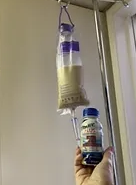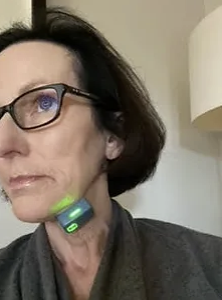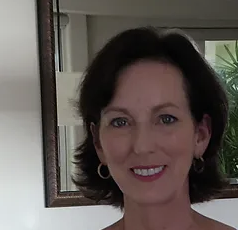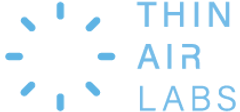Una Somerville speaks to me via a video call from a sunny room in the San Francisco apartment she shares with her husband. With her brown bob and warm, clever eyes, it’s easy to picture her heading out to dinner with a lively group of friends… something she used to do regularly.
But that’s not so simple anymore.

Una was diagnosed with cancer in 2007. It was at the base of her tongue and tonsils. Her Stanford doctors treated her aggressively, with surgery, chemotherapy and radiation, allowing for a complete recovery. But the radiation created scar tissue that makes it difficult for Una to swallow. To make matters worse, her cancer came back last year. And the invasive surgery following this most recent diagnosis left a good portion of her tongue numb.
Now, Una lives with dysphagia, the medical term for swallowing difficulties. This condition has had a profound effect on her quality of life. She has trouble enunciating properly, she’s lost much of her appetite and she’s lost confidence socializing over a meal.
“Last week we went out with some friends, things are just starting to open up here in San Francisco, the friends knew the owner of the restaurant, and they knew about my eating issue,” explains Una. “They were kind enough to ask the owner to make some pureed food for my meal, but they went to all the extra effort to do that, and yet I’m still not always sure I’ll be able to swallow, I’m not always sure it will actually go down the right way. It’s just the lack of confidence and stress of that situation.”
Una also struggles to consume enough calories every day, so she has to use a feeding tube.
These are common consequences of dysphagia, a condition that 1 in 25 people will experience in their lifetime.
The best way to improve these swallowing difficulties is to do daily exercises with a speech pathologist. But coming into the clinic to do these exercises every day is problematic for patients, says the CEO of True Angle, Dr. Jana Rieger. She witnessed this in her clinic regularly, which is why she and her team created the Mobili-T device.
“The problem with the in-clinic therapy was that people simply couldn't commit to coming into the clinic every day for weeks at a time. So, no one signed up for that therapy and instead they simply went home with a list of exercises to do at home. This was neither motivating for them, nor did they know if they were actually doing the exercises properly or with enough intensity. And what we know is that when patients are given home exercise in this format, very few of them actually do the exercises and fewer do them correctly. This issue was the genesis of the Mobili-T.”

Una’s therapist introduced her to the Mobili-T device. It's an app for a mobile phone which talks to a sensor Una wears under her chin. The device monitors her progress, sends reports to her clinician and keeps Una motivated to do her exercises every day.
“It forces me to think about my swallowing - because it tells you about the movement you’re supposed to accomplish. And it measures that for you. I can see right away if I’m putting enough effort into it, and I’m more thoughtful about the swallowing process.”
The device has also offered Una more insight into when her ability to talk and swallow are at their best, allowing her to better plan her days. “I tend to do better earlier in the day, and then it tends to trail off in the evening. You can see that variation in my capability.”
The Mobili-T device is life-changing for these dysphagia patients, improving their quality of life and empowering them to overcome seemingly insurmountable obstacles.
Una says her Mobili-T device is helping her reach her goal of getting off her feeding tube by the end of 2021.
“My therapist says I’m improving. I can tell, just because I'm not so heavily reliant on my feeding tube. If I had to, I could probably do a whole day eating on my own, it would be a challenge but I could do it.”
And that impact on patients is what Jana (centre) and her team are always thinking about as they continue to build True Angle. They’ve raised a 1.64M seed round, closed their first B2B enterprise sale with a large academic partner in California and they’ve initiated an Innovation Partnership Program which is a grass-roots user-feedback community of clinicians and patients.
Patients like Una.
“I think this device, because it’s an app on your phone, and your phone is always with you, it doesn’t take long to do, and I kinda treat it like my daily crossword puzzle with the New York Times. It’s very easy,” says Una. “In the time that I have been using it, I have seen my swallowing improve a lot and I am on track on my goal to kick the feeding tube by the end of the year.”

Learn more about True Angle and the Mobili-T device here.
IMAGES: COURTESY OF UNA SOMERVILLE AND TRUE ANGLE
.png)


